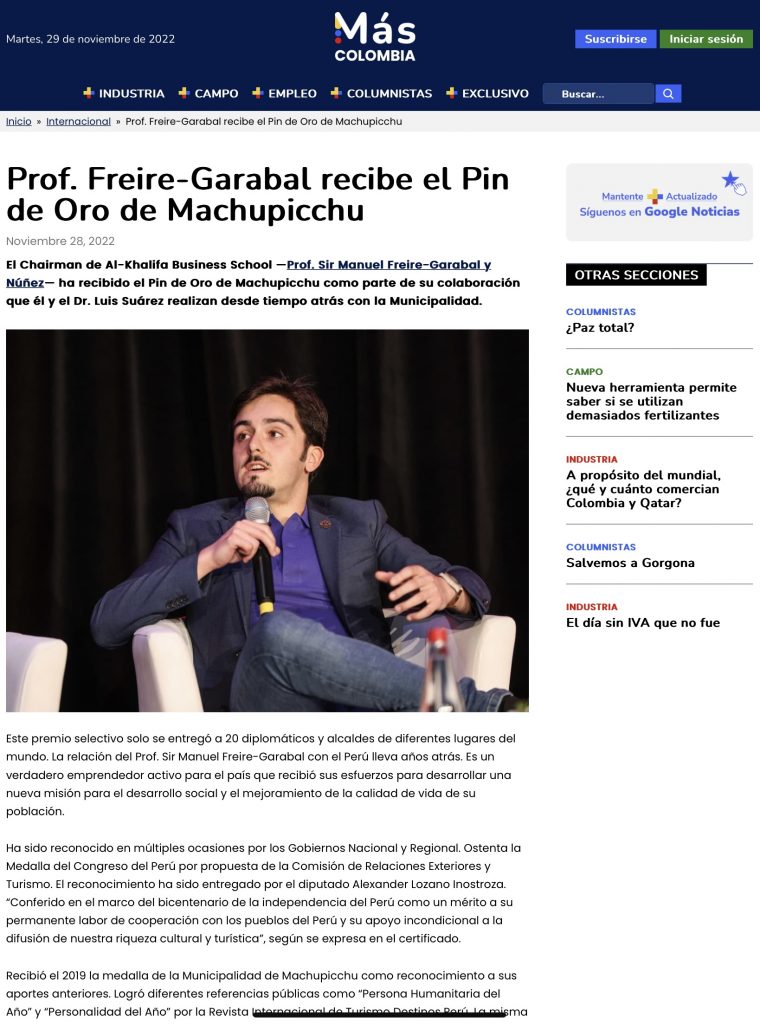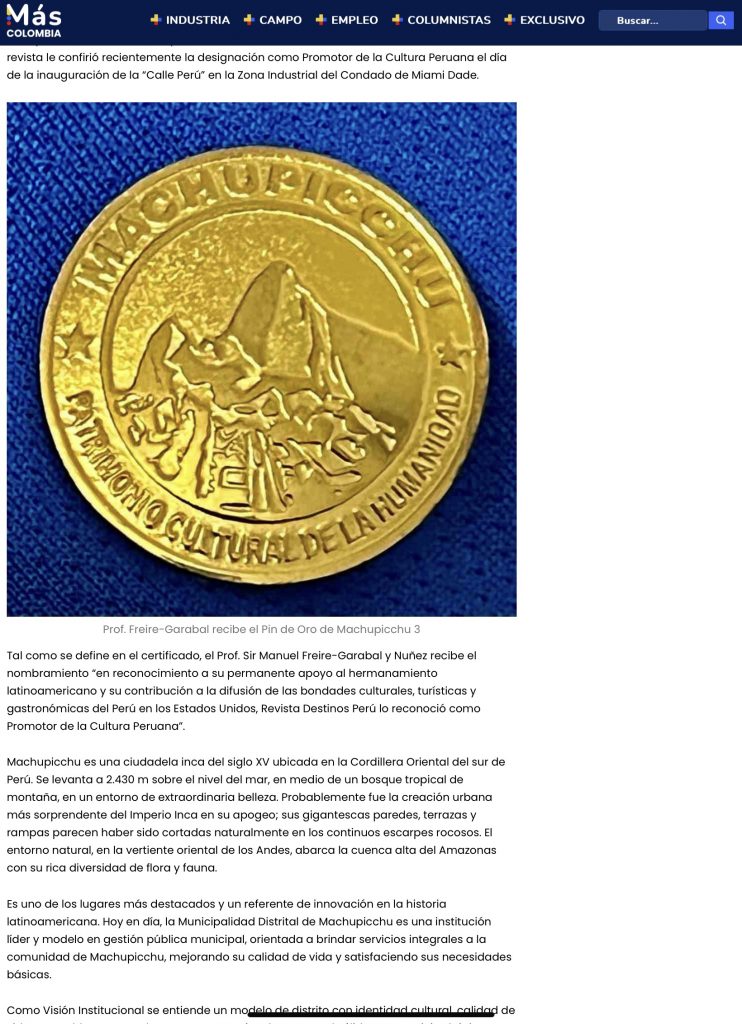
Translation of the article:
The Chairman of Al-Khalifa Business School —Prof. Sir Manuel Freire-Garabal y Núñez—has received the Machupicchu Gold Pin as part of his collaboration that he and Dr. Luis Suárez have been carrying out for some time with the Municipality.
This selective award was only given to 20 diplomats and mayors from different parts of the world. Prof. Sir Manuel Freire-Garabal’s relationship with Peru goes back years. He is a true active entrepreneur for the country that received his efforts to develop a new mission for social development and improvement of the quality of life of its population.
He has been recognized on multiple occasions by the National and Regional Governments. He holds the Medal of the Congress of Peru by proposal of the Foreign Relations and Tourism Commission. The recognition has been delivered by Deputy Alexander Lozano Inostroza. “Conferred within the framework of the bicentennial of the independence of Peru as a merit to its permanent work of cooperation with the peoples of Peru and its unconditional support for the dissemination of our cultural and tourist wealth”, as expressed in the certificate.

He received the Machupicchu Municipality medal in 2019 in recognition of his previous contributions. He achieved different public references such as “Humanitarian Person of the Year” and “Personality of the Year” by the International Tourism Magazine Destinos Perú. The same magazine recently awarded him the designation as Promoter of Peruvian Culture on the day of the inauguration of “Calle Perú” in the Industrial Zone of Miami Dade County.
As defined in the certificate, Prof. Sir Manuel Freire-Garabal y Nuñez received the appointment “in recognition of his permanent support for Latin American twinning and his contribution to the dissemination of the cultural, tourist and gastronomic benefits of Peru in the States Unidos, Destinos Perú Magazine recognized him as a Promoter of Peruvian Culture”.

Machupicchu is a 15th century Inca citadel located in the Eastern Cordillera of southern Peru. It rises to 2,430 m above sea level, in the middle of a tropical mountain forest, in an environment of extraordinary beauty. It was probably the most amazing urban creation of the Inca Empire at its height; its gigantic walls, terraces and ramps seem to have been cut naturally into the continuous rocky escarpments. The natural environment, on the eastern slopes of the Andes, encompasses the upper Amazon basin with its rich diversity of flora and fauna.
It is one of the most outstanding places and a benchmark for innovation in Latin American history. Today, the Machupicchu District Municipality is a leading institution and model in municipal public management, aimed at providing comprehensive services to the Machupicchu community, improving their quality of life and satisfying their basic needs.
The Institutional Vision is understood as a district model with cultural identity, acceptable quality of life, supported by a solid urban and rural economy, with equivalent basic and social services, in a healthy, sustainable and sustainable environment.
Machupicchu, consolidated as the Anteroom of the Inca city, Sanctuary of Machupicchu, with its physical spaces and services organized, orderly and ornamented, without oversizing in its urban growth, protected against risks of natural disasters; a safe, attractive and comfortable place for tourism and for the inhabitants, who actively participate in the government of the town in a concerted, harmonious, efficient, transparent, plural and democratic manner.
As stated by the National Government of Peru, the Management of local governments is a model of efficiency and transparency, through permanent participatory processes of all organized civil society, under the premise that the execution of development and participation plans by results is a fundamental task of all citizens. For this reason, this plan must be the concerted effort of all the inhabitants of the district, with the capacity to supervise and execute the process of democratic governance, under the principles of government of the people for the people.

On July 7, 2007, Machupicchu was elected one of the New 7 Wonders of the Modern World; these were chosen by more than 100 million people around the world, through an open vote on the Internet; the wonders were announced in random order by the New Open World Corporation (NOWC) and voted the world’s best destination in 2016 and home to some of the most amazing structures in the world.
For more information, the 7 wonders of the world are a set of amazing buildings, considered by many to be the 7 best buildings in the world. These are the seven wonders of the modern world, in no special order: The Great Wall of China (China), Petra (Jordan), Christ the Redeemer in Rio de Janeiro (Brazil), Machupicchu (Peru), Chichén Itzá (Mexico), The Rome Colosseum (Italy) and The Taj Mahal (India).


Comments are closed